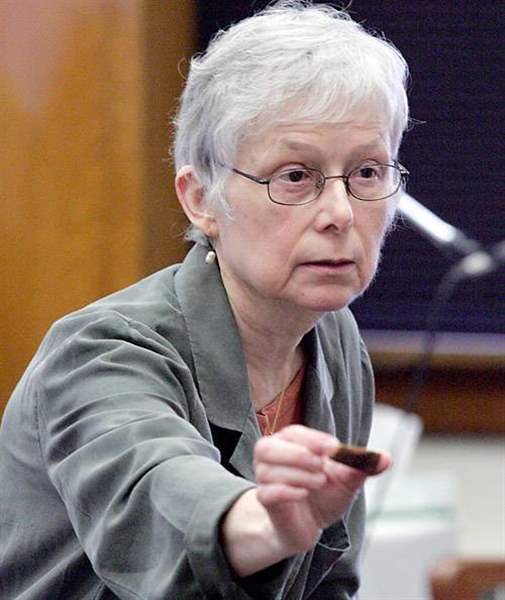
Jury begins deliberations in priest's murder trial
5/10/2006
Julie Saul shows the mandible of Sister Margaret Ann Pahl.
Judge Thomas Osowik ordered a half-hour break for lunch shortly before 2 p.m. after defense attorney Alan Konop made the second and last defense argument. Mr. Anderson began his comments around 2:30 p.m. and lastedfor about an hour.
Dean Mandros, chief of the criminal division of the Lucas County Prosecutor's Office, kicked off the prosecution's closing arguments earlier today by saying his case and all related physical evidence, though decades old, should stand the test of time.
"These stains are just the same," he said. But at the same time, Mr. Mandros
argued that the case had solidified in the years since."This is about the cold case, not the old case," he said. "We all agree in 1980, there wasn't enough proof."

Julie Saul shows the mandible of Sister Margaret Ann Pahl.
Since then, the prosecution argued, the fit of the murder weapon, a letter opener, into a wound in the nun's jawbone; blood-pattern transfer analysis similar to the blade on an alter cloth covering the body; and witness testimony regarding where Father Robinson and the nun were the day she was slain, presented a weighty argument for Father Robinson's guilt.At the same time, Mr. Mandros minimized his need to argue a motive in the slaying.
"I just have to show that he was the one who killed Margaret Ann Pahl," Mr. Mandros said.
In his closing lines, Mr. Mandros suggested that Father Robinson himself was
anticipating the jury's verdict."For all these years, he's been waiting, and now, he's waiting for you," he said.
Attorney John B. Thebes, speaking for the defense, began by attacking the physical evidence in the case - particularly that relating to blood-pattern transfer analysis, which he said was too subjective a practice to extend beyond a reasonable doubt.
"Every [prosecution] expert called ... was an expert in a subjective field," he said.
Mr. Thebes argued that a stain on an alter cloth covering the nun's body, as well as slashes in the nun's dress, better matched a pair of scissors rather than a curved letter opener. He also argued that there was no DNA evidence pertaining to the murder weapon, a letter opener.
"The criminal justice system depends on [DNA evidence]. It is objective," he said, assailing as disingenuous the prosecution's argument that DNA samplings from the scene were too small. "They turned a blind eye to the DNA," he said.
In summation, Mr. Thebes argued that the prosecution had rushed to fit a case around Father Robinson, ignoring any and all contradictory evidence.
"Do we really want a prosecution that arrests us first, and then does an investigation?" he asked the jury. "Is that what we want? We expect more."
The defense's argument was then handed off to attorney Alan Konop, who, fighting off illness, also argued that the prosecution had a largely circumstantial case and had ignored key evidence, including a blonde pubic hair at the crime scene. He further attacked the original 1980 police investigation into the murder, saying that investigators had not thoroughly investigated the crime scene, and had spoken of a report of an interrogation of Father Robinson, their key suspect, which later could not be found.
"They must be pretty darn desperate to have to blame it on the church," he said, referencing a prosecution effort to show that the Toledo Catholic Diocese had worked to cover up the case.
"Maybe they should blame it on their own investigation," Mr. Konop said.
Read more in later editions of The Blade and toledoblade.com.